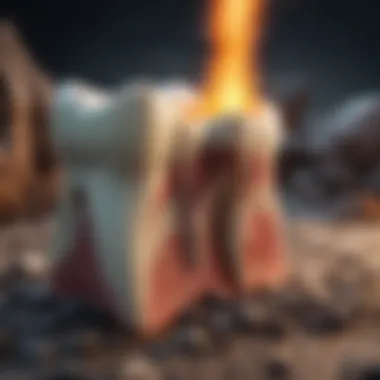Understanding Delayed Tooth Eruption: Causes and Management


Intro
Delayed tooth eruption is a common concern for many parents and caregivers. It can often lead to questions about a child's growth and overall health. Understanding the causes, implications, and management strategies associated with this phenomenon is crucial. Delayed eruption may stem from several factors, such as genetics, systemic disorders, and environmental influences. This article seeks to provide a comprehensive understanding of delayed tooth eruption to aid in addressing these concerns effectively.
Research Highlights
Overview of Key Findings
Research indicates that delayed tooth eruption generally varies among individuals. It can happen in primary and permanent teeth. Common causes include:
- Genetic factors: Family traits can play a role in the timing of tooth emergence.
- Systemic health conditions: Conditions like hypopituitarism or congenital hypothyroidism can alter eruption timelines.
- Nutritional deficiencies: Poor nutrition, especially in childhood, can impact growth and dental development.
Significance of the Research
Understanding delayed tooth eruption is significant for health professionals and parents alike. Accurate identification of the underlying causes allows for timely intervention. This can prevent further complications, such as malocclusion or misaligned teeth. Moreover, knowing the implications of delayed eruption reassures caregivers and guides them in making informed decisions about treatment options.
"Early detection and management of dental developmental issues can lead to better long-term oral health outcomes."
Implications for Oral Health
Delayed tooth eruption can lead to various oral health issues. These may include:
- Spacing problems: Delayed eruption can cause misalignment of teeth due to adjacent teeth shifting into the available space.
- Increased cavities risk: Irregular tooth alignment can make cleaning more difficult, leading to plaque buildup.
Addressing these concerns is essential to maintaining oral health. Regular dental check-ups can help monitor tooth development and implement preventive strategies.
Management Strategies
Management of delayed tooth eruption often involves a multidisciplinary approach. Here are several strategies that can be employed:
- Regular monitoring: Routine visits to the dentist ensure that any delays are acknowledged early.
- Eruption guidance: For some cases, orthodontic treatment may be necessary to guide teeth into proper position when they do emerge.
- Nutritional counseling: Addressing any deficiencies in a child's diet may promote better overall growth, including dental development.
Prologue to Delayed Tooth Eruption
Delayed tooth eruption is an important topic in pediatric dentistry and general health. Understanding this phenomenon is essential for both parents and healthcare professionals. Delayed eruption can indicate underlying health issues or developmental concerns. Timely intervention can help mitigate negative impacts on a child's overall health and well-being.
In this article, we explore several aspects related to delayed tooth eruption, including its definition, causes, implications for oral health, and management strategies. It is crucial to recognize the various factors that can contribute to this condition, as well as its potential effects on a child’s psychosocial development. For professionals and educators, grasping the nuances of this subject can guide better communication with families and patients.
Defining Delayed Tooth Eruption
Delayed tooth eruption refers to the postponement of normal tooth emergence beyond the expected age range. This term typically applies to primary (baby) teeth and can also affect permanent teeth. The timing of eruption can vary widely, influenced by genetic, environmental, and health-related factors.
Normal eruption timelines include:
- Primary teeth generally begin to emerge between 6 to 12 months of age.
- Permanent teeth erupt around 6 years of age.
A delay can create uncertainty among parents and caregivers, prompting concerns about a child's growth and development. Clearly defining delayed eruption allows for better assessment and intervention strategies to address potential issues effectively. Understanding this definition sets the stage for deeper exploration of the causes and implications, fostering a more informed perspective on this topic.
Physiological vs. Pathological Delays


Delayed tooth eruption can be classified into two main categories: physiological and pathological. Understanding the distinction between these two can significantly impact assessment and management strategies. Recognizing physiological delays can alleviate concerns for parents, as they are typically transient and not indicative of any underlying health issues. Meanwhile, pathological delays might signal more serious systemic problems that require immediate attention. Investigating these delays helps in formulating suitable management plans, ensuring optimal health outcomes for individuals.
Understanding Physiological Delays
Physiological delays in tooth eruption refer to variations in the timing of eruptions that occur without any concerning underlying conditions. These delays are usually part of the normal range of dental development. Factors influencing these physiological delays can include genetic predispositions as well as individual growth patterns. Children with a family history of late dental eruption may simply be following a similar trajectory. In such cases, the eruption process will likely continue without the need for interventions.
The significance of identifying physiological delays lies in reducing unnecessary worry and anxiety among caregivers. Many parents may observe that their child's teeth are taking longer to erupt than their peers and may fear a potential developmental issue. However, understanding that these delays can fall within normal parameters provides valuable reassurance. Monitoring progress is often sufficient, and early intervention is only recommended if a delay extends beyond the expected timeframe.
Identifying Pathological Delays
Pathological delays in eruption are those that signal underlying health issues that need crucial attention. These can stem from various factors, such as systemic health conditions, genetic disorders, and environmental influences. Identifying these delays involves careful evaluation and often requires a multidisciplinary approach. Conditions like hormonal imbalances, dental anomalies, or systemic diseases can all impede the normal eruption of teeth.
It is essential to consider both clinical examination techniques and radiographic assessments when diagnosing pathological delays. Irregularities such as lack of space in the dental arch or absence of tooth buds on X-rays can indicate problems that require interventions.
Key indicators of pathological delays can include:
- Specific patterns of tooth eruption that diverge from normal timelines
- Accompanying symptoms such as pain or swelling in the gums
- Presence of systemic illness affecting growth
Some factors that might lead to pathological delays are:
- Genetic conditions like hypohidrotic ectodermal dysplasia
- Nutritional deficiencies that impact overall health
- Environmental influences, such as exposure to certain toxins
Understanding these pathological delays emphasizes the importance of timely intervention. When these issues are identified early, professionals can implement tailored management strategies, which could improve the overall health of the child and mitigate long-term consequences.
Common Causes of Delayed Tooth Eruption
Understanding the common causes of delayed tooth eruption is critical in identifying issues that may affect oral health. Delayed eruption can manifest in various ways, impacting not only the appearance of a child’s smile but also their overall health. As professionals and caregivers, the insights into the underlying factors can create opportunities for timely intervention and management. Addressing these causes ensures a comprehensive approach to pediatric dental health.
Genetic Factors
Genetics play a significant role in determining the timing of tooth eruption. Specific hereditary conditions may delay this process, influencing not only the order but also the timing of eruption. For instance, conditions like ectodermal dysplasia can lead to fewer teeth or delayed eruption compared to the general population. Knowledge of a family history of dental anomalies can be a vital indicator for practitioners to monitor a child’s tooth development closely. Furthermore, understanding the genetic background allows for better counseling of parents regarding possible outcomes.
Systemic Health Conditions
Various systemic health conditions can impede the normal eruption of teeth. Conditions such as hypopituitarism, poorly controlled diabetes, and hyperparathyroidism can interfere with the body's hormonal balance, affecting tooth development. For example, in children with chronic diseases, the body prioritizes critical functions often at the expense of less crucial processes like dental development. Therefore, recognizing these health issues is fundamental for clinicians to provide a holistic approach to a patient’s dental health. Regular health evaluations and collaboration with pediatricians can help identify and manage such conditions.
Nutritional Deficiencies
Nutritional status significantly influences dental health and can lead to delayed tooth eruption. Deficiencies in essential vitamins and minerals, particularly calcium, vitamin D, and phosphorus, are known to affect tooth formation. Children with poor dietary intake might experience delayed or incomplete eruption of teeth. For example, ignoring these deficiencies can have long-lasting implications, not only affecting aesthetics but also putting children at higher risk for cavities and oral diseases. Ensuring a well-balanced diet rich in these nutrients is pivotal.
Environmental Influences
Environmental factors also play a role in delayed tooth eruption. Exposure to certain toxins or substances during critical developmental periods can alter the normal trajectory of dental development. For instance, a child who has been exposed to high levels of lead or fluoride may experience delays in tooth eruption. Moreover, socio-economic factors, such as access to healthcare and proper nutrition, can further exacerbate these challenges. Overall, being aware of environmental influences is essential for healthcare professionals to devise effective management strategies tailored to each child's unique situation.
"Identifying the causes of delayed tooth eruption early can prevent further complications and foster improved oral health engaged throughout childhood."
Diagnosing Delayed Tooth Eruption
Detecting delayed tooth eruption is crucial for addressing potential issues early. Parents and caregivers can worry about a child's growth when teeth do not appear on schedule. This concern is valid, as delayed eruption can have various implications for oral health. More importantly, it can also indicate underlying health issues that may need attention. A proper diagnosis requires a thorough examination and skilled assessment tools.
Clinical Examination Techniques


The first step in diagnosing delayed tooth eruption is a careful clinical examination. This may begin with an assessment of the child’s dental history and general health. The dentist or pediatrician will often check the child’s mouth for signs of teeth that are about to emerge. They will also evaluate the alignment and size of existing teeth. Through visual inspection, the healthcare provider can identify any swelling or tenderness around the gum tissue.
In addition, clinical exams may involve palpation of the dental ridges. This physical touch helps determine the presence of teeth that may be stuck below the gum line. Furthermore, timing of eruption can also play a significant role in the clinical approach. For instance, if a child is beyond the average age for initial tooth eruption and no teeth are present, this may warrant further investigation.
Radiographic Assessments
When clinical exams suggest possible delayed eruption, radiographic assessments become important. X-rays, such as panoramic radiographs, provide a clear view of the underlying dental structures. They can show whether any teeth are developing but have not yet emerged. This imaging technique allows professionals to identify potential issues such as impaction, which occurs when a tooth is blocked by another structure.
Radiographs can also reveal if there are any anomalies in the formation of teeth, like missing permanent teeth, or conditions such as cysts or tumors that may interfere with normal eruption. These assessments are critical for developing a comprehensive treatment plan.
Scheduling regular dental check-ups becomes essential as age progresses. Utilizing both clinical and radiographic methods ensures that any delays in tooth eruption can be monitored effectively. This approach aids in creating a timely intervention plan, ultimately supporting the child’s dental and overall health.
Impacts of Delayed Tooth Eruption
Understanding the impacts of delayed tooth eruption is crucial in both clinical practice and parental awareness. This section aims to shed light on how delays can affect both oral health and the psychosocial well-being of affected individuals. Recognizing these effects helps in making informed decisions regarding diagnosis, management, and intervention strategies. It is imperative to understand that the implications are not merely limited to dental aspects but encompass a wider range of physical and emotional considerations.
Effects on Oral Health
Delayed tooth eruption can lead to a variety of oral health issues. When teeth do not erupt in their expected time frame, it can disrupt the natural alignment of both primary and permanent teeth. This misalignment can exacerbate overcrowding, leading to further complications such as tooth decay and gum disease.
Common consequences include:
- Malocclusion: As teeth erupt, they guide one another into proper position. Delays can lead to issues with bite alignment, which can require orthodontic treatment.
- Increased Risk of Decay: Erupted teeth may not be properly positioned, making them harder to clean. This can result in plaque buildup and cavities.
- Impacted Teeth: Delays can lead to impaction, where a tooth is unable to properly erupt. This may require surgical interventions to alleviate pain and restore function.
In more severe cases, ongoing issues can affect overall oral functionality, leading to challenges with chewing, speaking, and aesthetic concerns.
Psychosocial Effects
The psychosocial effects of delayed tooth eruption should not be overlooked. Children and adolescents may experience emotional distress due to perceived differences in their dental appearance. Social interactions, self-esteem, and even academic performance can be influenced by one's oral health status. Key impacts include:
- Self-Image Issues: Children may feel self-conscious about their smiles, affecting their interactions with peers.
- Bullying or Social Exclusion: Problems with dental appearance can sometimes lead to teasing or bullying, resulting in social isolation.
- Anxiety and Stress: The stress of ongoing dental visits or treatment can lead to increased anxiety, which may manifest in various aspects of daily life.
Delayed tooth eruption is not solely a dental concern; it intertwines with emotional health and social dynamics.
Recognizing these psychosocial aspects is crucial for those involved in the care and support of affected individuals. Proper management strategies must encompass both oral and emotional support, fostering resilience and encouraging positive development.
Management Strategies for Delayed Tooth Eruption
Management strategies play a crucial role in addressing delayed tooth eruption. This section discusses essential elements that can help mitigate the effects of this condition. These strategies focus on monitoring, nutrition, and orthodontic considerations. Each approach has unique benefits and requires careful consideration of the child's overall health and development.
Monitoring and Observation
Monitoring and observation are foundational aspects in managing delayed tooth eruption. This strategy allows healthcare providers to assess the progress of tooth eruption over time. Regular dental check-ups are critical in identifying any potential issues early on. These visits enable practitioners to gather data about the child's dental growth, allowing for timely interventions if necessary.
Benefits of Monitoring:
- Early Detection: Discover any abnormalities or delays promptly.
- Tailored Approach: Adjust treatment plans based on individual needs.
Parents should be proactive in scheduling these visits, especially if there are noticeable delays. Keeping a record of dental changes can help track patterns and inform the dentist. The role of observation cannot be overstated; it provides a clearer picture of what the child is experiencing and can guide treatment decisions.
Nutritional Interventions


Nutritional interventions are another vital management strategy for delayed tooth eruption. Proper nutrition plays a significant role in dental health and development. Deficiencies in essential nutrients may lead to various health complications, including delayed tooth development.
Key Nutrients:
- Calcium: Needed for strong teeth and bones.
- Vitamin D: Facilitates calcium absorption.
- Phosphorus: Works with calcium for healthy dental structures.
Incorporating a diet rich in these nutrients can foster optimal oral health. Foods like dairy products, leafy greens, and fish should be encouraged. Furthermore, reducing sugary snacks and processed foods helps prevent cavities, which can complicate eruption timelines. Consulting with a pediatrician or nutritionist may also provide valuable insights tailored to the child's specific needs.
Orthodontic Considerations
Orthodontic considerations are essential when dealing with delayed tooth eruption. If teeth are not erupting as expected, orthodontic evaluations may become necessary. An orthodontist can assess the alignment of existing teeth and predict the future emergence of new ones.
What Orthodontists Can Do:
- Evaluate Dental Alignment: Check if existing teeth are impacting those yet to erupt.
- Predict Eruption Patterns: Analyze if there are underlying issues affecting the timing of eruption.
- Create a Treatment Plan: Recommend braces or other devices to prepare the mouth for upcoming teeth.
Early intervention can be advantageous, as it may mitigate the need for more extensive treatment later. That said, not every child with delayed eruption will require orthodontic interventions. Individual assessments are critical in determining the appropriate course of action.
Conclusion: A comprehensive management plan that includes monitoring, nutritional support, and orthodontic evaluations can significantly improve outcomes for children experiencing delayed tooth eruption. Staying informed about these strategies empowers parents and caregivers to seek better health outcomes for their children.
Future Research Directions
The understanding of delayed tooth eruption encompasses a variety of factors, many of which warrant further exploration. Future research can provide insights that contribute not only to clinical practice but also to the broader academic discourse surrounding this topic. Future studies could focus on genetic underpinnings and longitudinal health assessments. These areas are critical for enhancing our understanding of how delayed tooth eruption influences and is influenced by various systemic factors.
Genetic Studies
Investigation into genetic factors related to delayed tooth eruption holds significant promise. It is essential to explore how specific genetic markers may be linked to the timing of dental development. Current knowledge suggests that inherited traits can influence when teeth emerge, and identifying specific genes involved could improve prediction models for dental timelines.
A comprehensive genetic study could involve large sample sizes from diverse populations. Such an approach would allow researchers to discern patterns and variations in eruption timing across different demographics. Potential benefits of understanding genetic influences include:
- Targeted interventions based on genetic predispositions.
- Informed parental guidance regarding dental health timelines.
- Enhanced collaboration between geneticists and dental professionals, fostering a multidisciplinary approach.
Investments in genetic research can yield substantial dividends in understanding delayed tooth eruption. Insights here could shift paradigms in pediatric dentistry, ensuring timely provision of care tailored to individual needs.
Longitudinal Health Assessments
Longitudinal health assessments provide a unique lens through which to study delayed tooth eruption. This method allows researchers to observe and record changes over an extended period. By monitoring children from birth through adolescence, it is possible to capture data on various health factors that might correlate with tooth eruption.
Key considerations in these assessments include:
- The impact of systemic health conditions: Chronic illness could affect dental development timelines.
- The role of nutritional factors: Monitoring dietary intake over time may reveal trends in ethnic and socioeconomic groups.
- Environmental influences such as retaining dental health and its relation to delayed eruption.
The benefits of this approach are numerous. For example, it can uncover the nuances of children's developmental trajectories. Furthermore, it can identify critical intervention points that could assist in managing delayed tooth eruption effectively.
Finale
The discussion surrounding delayed tooth eruption is significant for both public and professional perspectives. In this article, we have examined critical aspects of this phenomenon, emphasizing its various causes, implications, and management strategies. Understanding delayed tooth eruption is essential because it can affect not just a child’s dental health, but also their overall development and emotional wellbeing. Parents and caregivers who can identify signs of delayed eruption are better equipped to seek timely intervention, reducing potential complications.
Summarizing these insights reveals several key considerations:
- Awareness of Causes: Recognizing the diverse factors that may contribute to delayed tooth eruption, such as genetic predispositions and systemic health issues, can empower caregivers to respond appropriately.
- Implications for Oral Health: The potential consequences of delayed eruption extend beyond aesthetics. Oral health issues can arise, necessitating proactive management to ensure comprehensive dental care.
- Management Strategies: Implementing appropriate monitoring, nutrition interventions, and orthodontic considerations can mitigate adverse outcomes. The strategies discussed highlight the need for individualized approaches based on unique circumstances of each child.
Understanding delayed tooth eruption not only informs treatment protocols but also fosters a supportive environment for children. The complexities of this topic underline the necessity for ongoing education and research in the field. Future studies should seek to further clarify the intersection between genetics and environmental factors in tooth development.
Embracing a multidisciplinary approach is crucial for addressing both the physical and emotional aspects of delayed tooth eruption.
In summary, delaying tooth eruption is a multifaceted issue that requires careful consideration. Equipping ourselves with knowledge helps us navigate this critical aspect of pediatric health more effectively.







